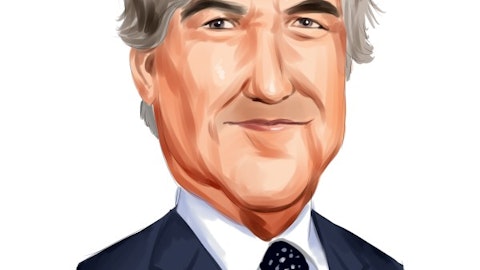Operator: Thank you. And our next question coming from the line of Sanjay Sakhrani with KBW. Your line is open.
Sanjay Sakhrani: Thanks. Good morning. Jack, could you provide us an update around the loan forgiveness plan? I think it’s with the Supreme Court right now. Maybe also just to the extent that it’s an adverse ruling, how you intend to proceed going forward?
Jack Remondi: Sure. So as I mentioned, it is at the Supreme Court, briefs have been filed from the Department of Education. The states or the plaintiffs briefs are due this Friday. Hearings will be scheduled sometime I think in February when the Supreme Court will issue their opinion is somewhat unknown. But obviously, we expect it before they recess in the June, July time frame. Right now, the proposal from the administration is only for direct loans. So FFELP loans are not eligible and borrowers cannot become €“ FFELP borrowers cannot become eligible via loan consolidation. So it’s not clear how that would necessarily impact on perception versus reality. But as Joe mentioned in his comments, last year, we saw a significant increase in consolidation activity of borrowers as they were hoping to qualify for various forgiveness initiatives from the administration or announced by the administration, that stopped and returned to pre-pandemic levels in December and January so far.
So we expect more of that. However, I think the politics of this make it an area that we will continue to watch very closely and be able to manage our portfolio and react to changes that maybe announced €“ future changes that maybe announced by the administration down the road.
Sanjay Sakhrani: Okay. Great. And then maybe just a question on economy and how you see your customers behaving? I think you added a little bit to the reserve this quarter. I mean, what are you guys assuming inside your economic forecast? And are you seeing any potential weakness of any kind?
Jack Remondi: Yes. So we €“ earlier last year, we began to be concerned about changes in economic outlook and reflect a more conservative position in terms of rising rates and potentially a significant or a mild slowdown in the economy. We’re still positioned for that. We look at our reserve and really see it is the hedging strategies that we’ve been able to employ those have helped mitigate the rise in rates that took place in 2022. So our NIMs were relatively stable. Our reserve levels, we believe are adequate for the economic outlook that we see in front of us. You’re definitely seeing some rising delinquency and charge-off rates in both our FFELP and private loan portfolios. These are consistent with what we were €“ well, they’re actually better than what we expected.
During the COVID €“ during the pandemic, we offered a number of different payment relief options and as those ended, some borrowers that were previously on a path to default slowed down and didn’t. And now they’re kind of jumping or bundling together, and you’re seeing some rise in delinquency and default rates. We expect those to return to more normalized levels next year. So the outlook for delinquencies and defaults remains pretty consistent with what we saw last year. But it does take into consideration a belief that we will have an economic slowdown here.
Sanjay Sakhrani: Okay. Great. Is there a specific like unemployment rate assumption you guys are using?
Jack Remondi: We would not in terms of the generic default rate. So our portfolio, when we look at what drives delinquencies and defaults in our portfolio, it’s really a function of where the borrowers are in their life cycle. So students who are graduating from college or leaving college early, that’s where we have our greatest exposure and where unemployment rates tend to have the biggest impact on delinquencies and defaults. We have a relatively small exposure to that right now. For borrowers that have been in repayment for extended periods of time, have high levels of income, high levels of employability. These are generally people who graduated, earn their degree and have an established career. We see less sensitivity to changes in unemployment rates.
And that’s been consistent for years and years or decades in the student loan space. Unemployment rates for college graduates typically run about half the national average. So while you might see those numbers spiking in different areas, they tend to impact college graduates €“ they definitely impact college graduates less than they do the rest of the populations.
Sanjay Sakhrani: Okay. Great. Thank you so much.
Operator: Thank you. And our next question coming from the line of Mark DeVries with Barclays. Your line is open.
Mark DeVries: Yes. Thanks. Just wanted to clarify some of the comments around the FFELP NIM and the guidance. Joe, did you imply that there was about an 11 basis point drag in the quarter from elevated prepayment speeds? And if that normalizes, that gets you to about 105 basis points kind of the midpoint of your guidance range for 2023?
Joe Fisher: That is correct. So the incremental activity was above what we were anticipating as we entered into this in the third quarter. So absent that impact, we would have been at 105 basis points.
Mark DeVries: Okay. Got it. And can you give us any sense of how kind of rate sensitive your guidance is for both the FFELP and private student loan NIM? If you got a 100 basis point rate shock kind of up or down, what might that do to your expected NIM?
Joe Fisher: So from a FFELP perspective, keep in mind, it’s really the pace at which it increases. So the assets themselves are resetting daily and our liabilities typically lag. So they’re resetting either monthly or quarterly. So as you’ve seen over the last year, you get a benefit as rates continue to increase. So for the first half of the year, where the expectation is that those rates continue to increase, you would see a little bit of a pickup before that levels out. So that 100 basis points shock upwards would be a benefit to us. Any downward movement that we would see in terms of where we are, we would start to benefit from a floor income perspective. So we feel pretty confident just based off of where the forward rate curve is today within our guidance of that 100 basis points to 110 basis points.
And then we provide the ultimate shocks in our Qs and Ks. So you can take a look at that of what that impact is for the overall earnings. Similarly, on the private side, the impact there is, again, you have the lag of assets that are earning off of prime and funded through LIBOR. So you have the reverse where there is a drag from the rate environment increasing. And then again, as we anticipate that leveling out in this back half of the year, you would get a slight benefit there.





